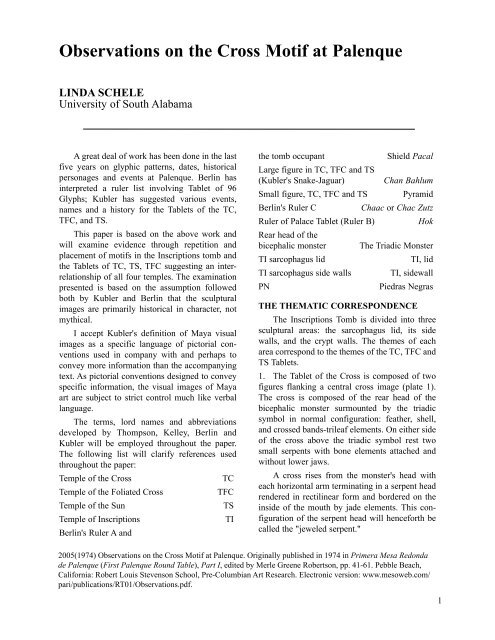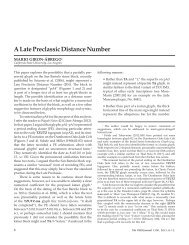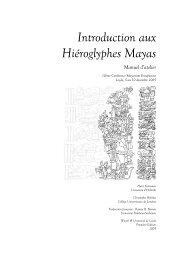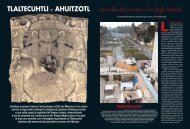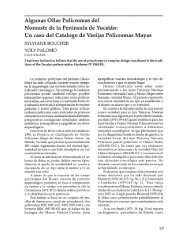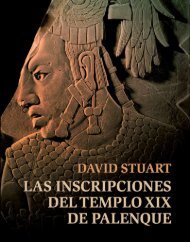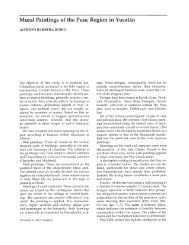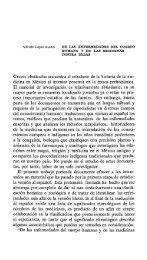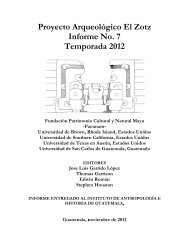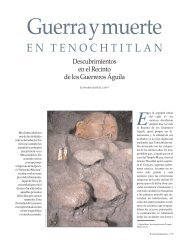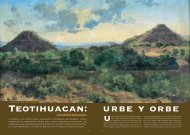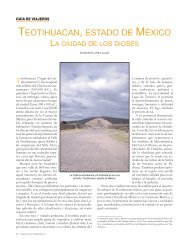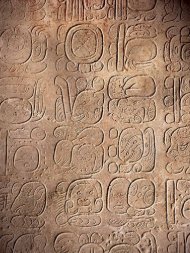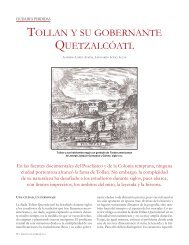Observations on the Cross Motif at Palenque - Mesoweb
Observations on the Cross Motif at Palenque - Mesoweb
Observations on the Cross Motif at Palenque - Mesoweb
Create successful ePaper yourself
Turn your PDF publications into a flip-book with our unique Google optimized e-Paper software.
<str<strong>on</strong>g>Observ<strong>at</strong>i<strong>on</strong>s</str<strong>on</strong>g> <strong>on</strong> <strong>the</strong> <strong>Cross</strong> <strong>Motif</strong> <strong>at</strong> <strong>Palenque</strong><br />
LINDA SCHELE<br />
University of South Alabama<br />
A gre<strong>at</strong> deal of work has been d<strong>on</strong>e in <strong>the</strong> last<br />
five years <strong>on</strong> glyphic p<strong>at</strong>terns, d<strong>at</strong>es, historical<br />
pers<strong>on</strong>ages and events <strong>at</strong> <strong>Palenque</strong>. Berlin has<br />
interpreted a ruler list involving Tablet of 96<br />
Glyphs; Kubler has suggested various events,<br />
names and a history for <strong>the</strong> Tablets of <strong>the</strong> TC,<br />
TFC, and TS.<br />
This paper is based <strong>on</strong> <strong>the</strong> above work and<br />
will examine evidence through repetiti<strong>on</strong> and<br />
placement of motifs in <strong>the</strong> Inscripti<strong>on</strong>s tomb and<br />
<strong>the</strong> Tablets of TC, TS, TFC suggesting an interrel<strong>at</strong>i<strong>on</strong>ship<br />
of all four temples. The examin<strong>at</strong>i<strong>on</strong><br />
presented is based <strong>on</strong> <strong>the</strong> assumpti<strong>on</strong> followed<br />
both by Kubler and Berlin th<strong>at</strong> <strong>the</strong> sculptural<br />
images are primarily historical in character, not<br />
mythical.<br />
I accept Kubler's definiti<strong>on</strong> of Maya visual<br />
images as a specific language of pictorial c<strong>on</strong>venti<strong>on</strong>s<br />
used in company with and perhaps to<br />
c<strong>on</strong>vey more inform<strong>at</strong>i<strong>on</strong> than <strong>the</strong> accompanying<br />
text. As pictorial c<strong>on</strong>venti<strong>on</strong>s designed to c<strong>on</strong>vey<br />
specific inform<strong>at</strong>i<strong>on</strong>, <strong>the</strong> visual images of Maya<br />
art are subject to strict c<strong>on</strong>trol much like verbal<br />
language.<br />
The terms, lord names and abbrevi<strong>at</strong>i<strong>on</strong>s<br />
developed by Thomps<strong>on</strong>, Kelley, Berlin and<br />
Kubler will be employed throughout <strong>the</strong> paper.<br />
The following list will clarify references used<br />
throughout <strong>the</strong> paper:<br />
Temple of <strong>the</strong> <strong>Cross</strong> TC<br />
Temple of <strong>the</strong> Foli<strong>at</strong>ed <strong>Cross</strong> TFC<br />
Temple of <strong>the</strong> Sun TS<br />
Temple of Inscripti<strong>on</strong>s TI<br />
Berlin's Ruler A and<br />
<strong>the</strong> tomb occupant<br />
Large figure in TC, TFC and TS<br />
Shield Pacal<br />
(Kubler's Snake-Jaguar) Chan Bahlum<br />
Small figure, TC, TFC and TS Pyramid<br />
Berlin's Ruler C Chaac or Chac Zutz<br />
Ruler of Palace Tablet (Ruler B)<br />
Rear head of <strong>the</strong><br />
Hok<br />
bicephalic m<strong>on</strong>ster The Triadic M<strong>on</strong>ster<br />
TI sarcophagus lid TI, lid<br />
TI sarcophagus side walls TI, sidewall<br />
PN Piedras Negras<br />
THE THEMATIC CORRESPONDENCE<br />
The Inscripti<strong>on</strong>s Tomb is divided into three<br />
sculptural areas: <strong>the</strong> sarcophagus lid, its side<br />
walls, and <strong>the</strong> crypt walls. The <strong>the</strong>mes of each<br />
area corresp<strong>on</strong>d to <strong>the</strong> <strong>the</strong>mes of <strong>the</strong> TC, TFC and<br />
TS Tablets.<br />
1. The Tablet of <strong>the</strong> <strong>Cross</strong> is composed of two<br />
figures flanking a central cross image (pl<strong>at</strong>e 1).<br />
The cross is composed of <strong>the</strong> rear head of <strong>the</strong><br />
bicephalic m<strong>on</strong>ster surmounted by <strong>the</strong> triadic<br />
symbol in normal c<strong>on</strong>figur<strong>at</strong>i<strong>on</strong>: fea<strong>the</strong>r, shell,<br />
and crossed bands-trileaf elements. On ei<strong>the</strong>r side<br />
of <strong>the</strong> cross above <strong>the</strong> triadic symbol rest two<br />
small serpents with b<strong>on</strong>e elements <strong>at</strong>tached and<br />
without lower jaws.<br />
A cross rises from <strong>the</strong> m<strong>on</strong>ster's head with<br />
each horiz<strong>on</strong>tal arm termin<strong>at</strong>ing in a serpent head<br />
rendered in rectilinear form and bordered <strong>on</strong> <strong>the</strong><br />
inside of <strong>the</strong> mouth by jade elements. This c<strong>on</strong>figur<strong>at</strong>i<strong>on</strong><br />
of <strong>the</strong> serpent head will henceforth be<br />
called <strong>the</strong> "jeweled serpent."<br />
2005(1974) <str<strong>on</strong>g>Observ<strong>at</strong>i<strong>on</strong>s</str<strong>on</strong>g> <strong>on</strong> <strong>the</strong> <strong>Cross</strong> <strong>Motif</strong> <strong>at</strong> <strong>Palenque</strong>. Originally published in 1974 in Primera Mesa Red<strong>on</strong>da<br />
de <strong>Palenque</strong> (First <strong>Palenque</strong> Round Table), Part I, edited by Merle Greene Roberts<strong>on</strong>, pp. 41-61. Pebble Beach,<br />
California: Robert Louis Stevens<strong>on</strong> School, Pre-Columbian Art Research. Electr<strong>on</strong>ic versi<strong>on</strong>: www.mesoweb.com/<br />
pari/public<strong>at</strong>i<strong>on</strong>s/RT01/<str<strong>on</strong>g>Observ<strong>at</strong>i<strong>on</strong>s</str<strong>on</strong>g>.pdf.<br />
1
Fig. 1a & b. Temple of Inscripti<strong>on</strong>s, Sarcophagus sides (a) east (6) north (Rubbing by Merle Greene 1967 Pls. 20 and 17).<br />
Atop <strong>the</strong> cross stands a mythical bird complete<br />
with head mask, serpent wing, pectoral, and<br />
a m<strong>at</strong>, jade element hanging from his mouth.<br />
The TI lid (pl<strong>at</strong>e 4) presents a figure falling in<br />
fr<strong>on</strong>t of a similar cross motif. The cross rises from<br />
<strong>the</strong> same m<strong>on</strong>ster head as seen in TC with <strong>the</strong><br />
excepti<strong>on</strong> th<strong>at</strong> <strong>the</strong> crossed band element has been<br />
replaced by <strong>the</strong> "cimi" de<strong>at</strong>h sign in <strong>the</strong> triadic<br />
symbol. The m<strong>on</strong>ster's head is flanked <strong>on</strong> ei<strong>the</strong>r<br />
side by a skeletal serpent with jaws opened <strong>at</strong> a<br />
90° angle.<br />
The cross rises from <strong>the</strong> m<strong>on</strong>ster's head and<br />
termin<strong>at</strong>es all three arms in <strong>the</strong> same jeweled serpent<br />
as <strong>the</strong> TC <strong>Cross</strong>. The internal signs engraved<br />
<strong>on</strong> <strong>the</strong> TC and TI lid crosses differ.<br />
The TC and TI lid serpent-birds are identical<br />
including <strong>the</strong> elements falling from <strong>the</strong> mouth<br />
and <strong>the</strong> shell signs <strong>at</strong>tached to <strong>the</strong> forehead. A<br />
sun-Ahau sign is <strong>at</strong>tached to or near each tail. It<br />
is important to notice th<strong>at</strong> <strong>the</strong> pectoral and head<br />
details of <strong>the</strong> TFC bird are different from <strong>the</strong> TC<br />
and TI birds.<br />
A double headed serpent bar is draped around<br />
both crosses, passing in fr<strong>on</strong>t of <strong>the</strong> vertical members<br />
and behind <strong>the</strong> horiz<strong>on</strong>tals. Each serpent head<br />
is <strong>the</strong> l<strong>on</strong>gnosed, fanged variety with corn elements<br />
<strong>at</strong>tached. The same m<strong>at</strong>-jade element associ<strong>at</strong>ed<br />
with <strong>the</strong> TI and TC serpent-birds emerge<br />
from <strong>the</strong> mouths of <strong>the</strong> TC serpent heads. Effigy<br />
gods emerge from <strong>the</strong> mouths of <strong>the</strong> TI serpents;<br />
<strong>the</strong> flare god emerges from <strong>the</strong> left head and a god<br />
I shall call <strong>the</strong> "jester god" from <strong>the</strong> left head.<br />
The serpent body of <strong>the</strong> TC serpent is composed<br />
of altern<strong>at</strong>ed jade and yax signs. The body<br />
2
Fig. 2. Temple of Inscripti<strong>on</strong>s, Tomb stucco figure 7 (Merle<br />
Greene Roberts<strong>on</strong> photo).<br />
of <strong>the</strong> TI serpent is ei<strong>the</strong>r intersected or encircled<br />
by jade rings.<br />
The TI lid and <strong>the</strong> TC Tablet are bordered<br />
by sky bands. All of <strong>the</strong> signs in <strong>the</strong> TC band are<br />
repe<strong>at</strong>ed in <strong>the</strong> TI lid band, although some of <strong>the</strong><br />
TI lid signs are not in <strong>the</strong> TC band.<br />
Finally, many of <strong>the</strong> signs found <strong>on</strong> each tablet,<br />
including jeweled Ahaus or Sun Gods, shell<br />
in profile or fr<strong>on</strong>t view, and jade-b<strong>on</strong>e signs, are<br />
suspended in <strong>the</strong> neg<strong>at</strong>ive spaces of both tablets.<br />
2. The Tablet of <strong>the</strong> TFC (pl<strong>at</strong>e 3) is composed<br />
of <strong>the</strong> same figures as seen in <strong>the</strong> TC Tablet flanking<br />
ano<strong>the</strong>r cross. The cross rests <strong>on</strong> a m<strong>on</strong>ster<br />
head, which may represent <strong>the</strong> earth, but which<br />
definitely differs from <strong>the</strong> TC and TI triadic m<strong>on</strong>sters.<br />
A Kan <strong>Cross</strong> is inset into <strong>the</strong> forehead and<br />
corn elements surround <strong>the</strong> head.<br />
Fig. 3. Temple of Inscripti<strong>on</strong>s, Tomb stucco figure 7, det.,<br />
shield (Merle Greene Roberts<strong>on</strong> photo).<br />
The shaft of <strong>the</strong> cross rises from <strong>the</strong> m<strong>on</strong>ster's<br />
head to be crowned by <strong>the</strong> Sun God. 1 A pectoral<br />
with a rare fr<strong>on</strong>t view head hangs from <strong>the</strong> cross;<br />
from it dangles a mask element frequently found<br />
in loin cloths of portrait figures.<br />
A god is <strong>at</strong>tached to ei<strong>the</strong>r side of <strong>the</strong> cross;<br />
elabor<strong>at</strong>e corn scrolls extend from each head to<br />
form <strong>the</strong> arms of <strong>the</strong> cross. A Maya head with<br />
bre<strong>at</strong>h signs nestles in each corn leaf cluster as<br />
would an ear of corn.<br />
O<strong>the</strong>r motifs of interest include <strong>the</strong> shell and<br />
emerging god bene<strong>at</strong>h "Pyramid," <strong>the</strong> right figure.<br />
The Maya head within <strong>the</strong> leaves is without bre<strong>at</strong>h<br />
sign.<br />
According to Joralem<strong>on</strong>, "Pyramid" is holding<br />
a penis perfor<strong>at</strong>or, <strong>the</strong> male instrument of<br />
self-sacrifice.<br />
1 During <strong>the</strong> c<strong>on</strong>ference, <strong>the</strong> similarity of <strong>the</strong> so-called Sun God to <strong>the</strong> "north star" head of <strong>the</strong> sky-bands was pointed out. The<br />
sky-band head is a secti<strong>on</strong>al profile of <strong>the</strong> god <strong>at</strong>op <strong>the</strong> foli<strong>at</strong>ed cross. I have serious reserv<strong>at</strong>i<strong>on</strong>s about identifying this head<br />
as <strong>the</strong> north star. He reappears <strong>on</strong> <strong>the</strong> shaft of <strong>the</strong> TI lid cross, emerging from behind <strong>the</strong> figure.<br />
3
Fig. 4. Palace, House A, Pier c (Merle Greene Roberts<strong>on</strong> photo, 1973).<br />
4
The left figure stands <strong>on</strong> a tri-headed god with<br />
glyphs in each eye. Corn leafs swirl from <strong>the</strong> head<br />
and triangles of circular jade-like elements are<br />
found <strong>on</strong> <strong>the</strong> muzzle and forehead. The identical<br />
head with glyphs in <strong>the</strong> eyes and mouth is found<br />
<strong>on</strong> <strong>the</strong> rear of Stela B, Copan. A face mask element<br />
similar to <strong>the</strong> TFC <strong>Cross</strong> pectoral is in <strong>the</strong><br />
loin cloth of <strong>the</strong> Stele B figure.<br />
Ten figures are presented <strong>on</strong> <strong>the</strong> TI sarcophagus<br />
sides (fig. 1). Kubler believes <strong>the</strong>y represent<br />
three men and <strong>on</strong>e woman (Kubler 1969:27-28).<br />
The North 1 and South 2 figures both have oddly<br />
blunt figures and lineal scarific<strong>at</strong>i<strong>on</strong> <strong>on</strong> <strong>the</strong> cheek.<br />
It has been suggested th<strong>at</strong> <strong>the</strong> figure shown exhibits<br />
a c<strong>on</strong>genital or amput<strong>at</strong>i<strong>on</strong> deformity. The c<strong>on</strong>tour<br />
of <strong>the</strong> nose of <strong>the</strong> North 2 and South 1 figures<br />
is ra<strong>the</strong>r large and different from o<strong>the</strong>r profiles<br />
presented. The careful present<strong>at</strong>i<strong>on</strong> of such characteristic<br />
differences str<strong>on</strong>gly suggests specific<br />
portraiture, not mythological generalities.<br />
Each figure rises from a ground line carefully<br />
depressed in a crack-like p<strong>at</strong>tern around each figure.<br />
Earth-query marks identify <strong>the</strong> ground line as<br />
<strong>the</strong> earth (Kubler 1969:27). A tree emerges from<br />
behind each figure laden with specific edible<br />
fruits which include cacao, aguac<strong>at</strong>e, guanavana<br />
and chico zapote. The leaf p<strong>at</strong>tern of <strong>the</strong> trees is<br />
not specific but ra<strong>the</strong>r is th<strong>at</strong> appearing often in<br />
associ<strong>at</strong>i<strong>on</strong> with god figures, specifically in <strong>the</strong><br />
line drawing <strong>on</strong> <strong>the</strong> floor of TI and perhaps in <strong>the</strong><br />
Oval Palace Tablet, right figure.<br />
The TI and TFC compositi<strong>on</strong>s specifically<br />
rel<strong>at</strong>e through present<strong>at</strong>i<strong>on</strong> of <strong>the</strong> motifs of <strong>the</strong><br />
emergence of main elements from <strong>the</strong> earth and<br />
<strong>the</strong> presence of tree or plant forms purposefully<br />
associ<strong>at</strong>ed with major food bearing plants. In<br />
additi<strong>on</strong> Chan-Bahlum offers <strong>the</strong> jester god to <strong>the</strong><br />
<strong>Cross</strong> in TFC; <strong>the</strong> head of <strong>the</strong> same god appears in<br />
<strong>the</strong> headdresses of six of <strong>the</strong> TI sar. figures, while<br />
God C appears in <strong>the</strong> o<strong>the</strong>r four.<br />
3. The Temple of <strong>the</strong> Sun (pl<strong>at</strong>e 2) repe<strong>at</strong>s <strong>the</strong><br />
compositi<strong>on</strong> of <strong>the</strong> TC and TFC Tablets. The<br />
same two figures flank a central shield portraying<br />
<strong>the</strong> Jaguar God of Number 7 (Kelley 1965:102).<br />
Serpent spears are crossed behind <strong>the</strong> shield. The<br />
shield and spear appear in c<strong>on</strong>juncti<strong>on</strong> <strong>at</strong> many<br />
o<strong>the</strong>r sites, including B<strong>on</strong>ampak, Stele 1.<br />
A rigid serpent bar rests below <strong>the</strong> shield, supported<br />
by two gods, <strong>on</strong>e of which, God L (Kelley<br />
1965:99) appears <strong>on</strong> <strong>the</strong> East TC jamb panel. A<br />
fr<strong>on</strong>t view, open-mou<strong>the</strong>d jaguar is mounted in<br />
<strong>the</strong> center of <strong>the</strong> serpent bar. The same jaguar<br />
face appears as <strong>the</strong> pectoral of <strong>the</strong> central figures<br />
in <strong>the</strong> Palace Tablet, <strong>the</strong> Tablet of <strong>the</strong> Slaves, No.<br />
7 Stucco figure in <strong>the</strong> TI Tomb and <strong>on</strong> <strong>the</strong> figure,<br />
west TC jamb. The pectorals may be a short-hand<br />
substitute for <strong>the</strong> TS serpent bar.<br />
Chan-Bahlum and "Pyramid" each stands <strong>on</strong><br />
a crouched pers<strong>on</strong> wearing god masks and body<br />
marks. The right bearer (TS) may reappear as<br />
<strong>the</strong> bearer of <strong>the</strong> left figure in <strong>the</strong> Tablet of <strong>the</strong><br />
Slaves. The left bearer's (TS) mask resembles <strong>the</strong><br />
Fig. 5. Temple of <strong>Cross</strong>, West Sanctuary Jamb (Rubbing by<br />
Merle Greene: 1967 Pl. 31).<br />
5
Fig. 6. Turtle shells (a) Temple of <strong>Cross</strong>, west jamb, from <strong>the</strong> headdress (b) Temple of Inscripti<strong>on</strong>s, sarcophagus lid, det. main<br />
figure, pectoral.<br />
Sun God face appearing in <strong>the</strong> headdresses of <strong>the</strong><br />
main figures, east piers, Palace.<br />
"Pyramid" holds an effigy god, which to my<br />
knowledge is unique to <strong>Palenque</strong>. It has an oddly<br />
shaped head and holds a shield which appears to<br />
be a stretched human face skin. I believe he reappears<br />
in a simplified form (head and shield) as <strong>the</strong><br />
offering presented by <strong>the</strong> right figure in <strong>the</strong> Palace<br />
Tablet and <strong>the</strong> Tablet of <strong>the</strong> Slaves. In both cases<br />
<strong>the</strong> figures are female.<br />
Chan-Bahlum holds a full-figured flare god<br />
effigy. The flare god is frequently used and is an<br />
important god in <strong>Palenque</strong>'s ic<strong>on</strong>ography. The p<strong>at</strong>tern<br />
of its appearance will be discussed l<strong>at</strong>er.<br />
The nine stucco figures (fig. 2) <strong>on</strong> <strong>the</strong> crypt<br />
walls are am<strong>on</strong>g <strong>the</strong> most elabor<strong>at</strong>ely dressed<br />
figures in <strong>Palenque</strong>'s sculpture. All face north or<br />
west; <strong>the</strong> TS is <strong>the</strong> west temple and Chan-Bahlum,<br />
<strong>the</strong> <strong>Palenque</strong>ño, is <strong>on</strong> <strong>the</strong> north side of <strong>the</strong> TS tablet.<br />
The stucco figures are large, standing approxim<strong>at</strong>ely<br />
6 ft. tall without headdress. Each holds a<br />
shield (fig. 3) identical to <strong>the</strong> TS shield in <strong>on</strong>e<br />
hand. The o<strong>the</strong>r hand holds a short serpent scepter<br />
termin<strong>at</strong>ing in <strong>the</strong> head of <strong>the</strong> flare god.<br />
The costumes of <strong>the</strong> tomb figures are unusually<br />
elabor<strong>at</strong>e for <strong>Palenque</strong>, but many fe<strong>at</strong>ures are<br />
repe<strong>at</strong>ed elsewhere. The presence of <strong>the</strong> same general<br />
costume <strong>on</strong> <strong>the</strong> East piers of <strong>the</strong> Palace (fig.<br />
4), which are generally accepted as portraiture,<br />
may help to support my premise th<strong>at</strong> <strong>the</strong> tomb figures<br />
are as much portraiture as mythological. The<br />
third figure rel<strong>at</strong>ed to <strong>the</strong> specialized costuming of<br />
<strong>the</strong> tomb stuccos is found <strong>on</strong> <strong>the</strong> figure of <strong>the</strong> west<br />
jamb, TC sanctuary (fig. 5).<br />
The headdresses of all <strong>the</strong> groups of figures<br />
while different in detailing are c<strong>on</strong>structed of 5<br />
main characteristics:<br />
1. A major mask or domed mass with cantilevered<br />
mask.<br />
2. Serpent-wing to <strong>the</strong> rear of <strong>the</strong> main<br />
mass.<br />
3. Small god heads or animal figures mounted<br />
<strong>at</strong>op <strong>the</strong> main mass.<br />
4. Two main fea<strong>the</strong>r masses, <strong>on</strong>e emerging<br />
from <strong>the</strong> top and <strong>on</strong>e from <strong>the</strong> rear.<br />
5. "Fish-e<strong>at</strong>ing plants" motifs or similar<br />
forms emerging from behind <strong>the</strong> serpent-wing.<br />
The headdresses of <strong>the</strong> TC jamb and tomb<br />
6
Fig. 7. Jaguar details (a) Temple of Sun; (b) Palace Tablet; (c) Palace Tablet; (d) Tablet of Slaves; (e) Temple of <strong>Cross</strong>, west sanctuary<br />
jamb; (f) Temple of Inscripti<strong>on</strong>s, sarcophagus lid; (g) Temple of Inscripti<strong>on</strong>s, tomb stucco 7; (h) Palace, House D, Pier f.<br />
figures share <strong>on</strong>e fur<strong>the</strong>r and rare fe<strong>at</strong>ure — a<br />
rectilinear jawstrap including an ear plug and<br />
composed of serpent or god fe<strong>at</strong>ures. The strap in<br />
nei<strong>the</strong>r case is presented as <strong>the</strong> lower jaw of <strong>the</strong><br />
main headdress mask; instead each is presented as<br />
a separ<strong>at</strong>e serpent or god form. To my knowledge<br />
this strap fe<strong>at</strong>ure appears in no o<strong>the</strong>r loc<strong>at</strong>i<strong>on</strong> in<br />
<strong>Palenque</strong>.<br />
All three groups of figures wear elabor<strong>at</strong>e jade<br />
capes, jaguar skirts, belts with mounted masks,<br />
and jaguar sandals with crossed straps rising to<br />
<strong>the</strong> knees. The high strapped sandals are unusual<br />
in <strong>Palenque</strong> sculpture.<br />
Finally, <strong>the</strong> tomb and Palace figures both hold<br />
shafts bearing <strong>the</strong> flare god as major fe<strong>at</strong>ures. The<br />
TC figure holds an inverted scepter with <strong>the</strong> triadic<br />
god and falling w<strong>at</strong>er symbols.<br />
If <strong>the</strong> costumes of <strong>the</strong> Maya pers<strong>on</strong>s can be<br />
accepted as a specific visual vocabulary of signs<br />
and symbols indic<strong>at</strong>ing office, functi<strong>on</strong>, cerem<strong>on</strong>y,<br />
lineage, etc. <strong>the</strong>n <strong>the</strong> three groups of figures in<br />
<strong>the</strong> TI tomb, TC jamb and east piers, Palace, are<br />
engaged in a similar activity or represent holders<br />
of <strong>the</strong> same office. At <strong>the</strong> very least, <strong>the</strong> fe<strong>at</strong>ures<br />
of dress str<strong>on</strong>gly indic<strong>at</strong>e <strong>the</strong> pers<strong>on</strong>ages presented<br />
in <strong>the</strong> tomb stuccos and <strong>the</strong> TC jamb are historical,<br />
not mythological.<br />
I have <strong>at</strong> present no specul<strong>at</strong>i<strong>on</strong>s as to <strong>the</strong><br />
identity of <strong>the</strong> tomb figures, but I believe <strong>the</strong> figure<br />
in <strong>the</strong> TC jamb can be identified. The inscrip-<br />
7
ti<strong>on</strong> includes two lord names including <strong>the</strong> lord<br />
prefixes identified by Berlin and <strong>the</strong> main signs<br />
identified by Kubler. The name of Lord Jaguar-<br />
Snake or Chan-Bahlum identified by Kubler<br />
(1972) as <strong>the</strong> large figure in <strong>the</strong> TFC, TC, TS<br />
tablets, appears <strong>at</strong> E2. The name, Lord Sunshield,<br />
T 624a, or Pacal identified by Kubler as <strong>the</strong> pers<strong>on</strong><br />
of <strong>the</strong> Inscripti<strong>on</strong>s tomb, appears <strong>at</strong> E6. The<br />
identifying text <strong>the</strong>n probably refers to <strong>on</strong>e of <strong>the</strong><br />
two rulers.<br />
Fe<strong>at</strong>ures of <strong>the</strong> visual image help to clarify <strong>the</strong><br />
identific<strong>at</strong>i<strong>on</strong>.<br />
Fig. 8. Palace, House D, Pier c detail, scepter, left figure (Merle Greene Roberts<strong>on</strong> photo 1973).<br />
1. The body of <strong>the</strong> bird <strong>at</strong>op <strong>the</strong> headdress<br />
has a tortoise shell body very similar to<br />
<strong>the</strong> pectoral worn by <strong>the</strong> falling figure<br />
in <strong>the</strong> TI lid (fig. 6). The presence of <strong>the</strong><br />
same ra<strong>the</strong>r strange motif would support a<br />
rel<strong>at</strong>i<strong>on</strong>ship between <strong>the</strong> figures.<br />
2. A jaguar head appears <strong>on</strong> <strong>the</strong> belt of <strong>the</strong><br />
TC figure and recalls <strong>the</strong> TS jaguar <strong>on</strong> <strong>the</strong><br />
serpent bar, <strong>the</strong> belt jaguar of West Pier f,<br />
Palace, <strong>the</strong> belt of <strong>the</strong> figure, sarcophagus<br />
lid, and <strong>the</strong> thr<strong>on</strong>e for <strong>the</strong> left figure <strong>on</strong><br />
<strong>the</strong> Palace Tablet (fig. 7). Seemingly <strong>the</strong><br />
8
Fig. 9. Profiles of Lord Chan-Bahlum: (a) Temple of Sun; (b) Temple of Foli<strong>at</strong>ed <strong>Cross</strong>; (c) Temple of <strong>Cross</strong>, West sanctuary<br />
jamb; (d) Temple 14.<br />
figure, as are o<strong>the</strong>rs including Pacal, is<br />
associ<strong>at</strong>ed with <strong>the</strong> jaguar.<br />
3. The figure holds an inverted scepter<br />
with <strong>the</strong> triadic m<strong>on</strong>ster. It is identical to<br />
<strong>the</strong> object held by "Pyramid" in <strong>the</strong> TC<br />
main tablet. The <strong>on</strong>ly o<strong>the</strong>r figure holding<br />
a similar object appears in West Pier<br />
c, Palace. The Pier c (fig. 8) scepter is<br />
upright and composed of elements identical<br />
to <strong>the</strong> TC cross motifs. A tri-branched<br />
cross of three jeweled serpents rise from<br />
<strong>the</strong> triadic m<strong>on</strong>ster's head. I suggest th<strong>at</strong><br />
<strong>the</strong> Pier c scepter is a short-hand, transportable<br />
object meant to exactly represent<br />
<strong>the</strong> ic<strong>on</strong>ographical c<strong>on</strong>tent of <strong>the</strong> cross<br />
image in <strong>the</strong> TC Tablet and sarcophagus<br />
lid. The crossed band sign and <strong>the</strong> profile<br />
jeweled shell are <strong>at</strong>tached to <strong>the</strong> Pier c<br />
scepter and appear prominently in <strong>the</strong> TC<br />
and TI lid compositi<strong>on</strong>s.<br />
4. The final and most important evidence<br />
is presented through a comparis<strong>on</strong> of <strong>the</strong><br />
jamb face profile to <strong>the</strong> TC, TS and TFC<br />
faces of Chan-Bahlum. I believe <strong>the</strong> specific<br />
c<strong>on</strong>tour of <strong>the</strong> nose and general form<br />
of <strong>the</strong> faces, especially in <strong>the</strong> chin area<br />
favor str<strong>on</strong>gly an identific<strong>at</strong>i<strong>on</strong> of <strong>the</strong> TC<br />
jamb figure as "Lord Chan-Bahlum." The<br />
profile str<strong>on</strong>gly supports in additi<strong>on</strong> an<br />
identific<strong>at</strong>i<strong>on</strong> of <strong>the</strong> right figure in Tablet<br />
XIV as Chan-Bahlum.<br />
THE EFFIGY GODS<br />
Three effigy gods appear with c<strong>on</strong>sistent p<strong>at</strong>tern<br />
in <strong>the</strong> TC, TFC, TS and TI tomb (fig. 9) and<br />
throughout <strong>Palenque</strong>'s sculpture. The specialized<br />
presence of <strong>the</strong>se gods in <strong>Palenque</strong> seem to indic<strong>at</strong>e<br />
specific functi<strong>on</strong> c<strong>on</strong>nected to but not limited<br />
to <strong>the</strong>ir present<strong>at</strong>i<strong>on</strong> in <strong>the</strong> TS, TC, TFC and TI<br />
Tomb sculptures.<br />
1. The "jester" god is held by Chan-Bahlum<br />
in TFC and in TC (in a reclining positi<strong>on</strong>).<br />
He emerges from <strong>the</strong> left serpent head of<br />
<strong>the</strong> serpent bar, TI lid. He appears c<strong>on</strong>sistently<br />
as a head in many headdresses,<br />
especially in <strong>the</strong> figures of <strong>the</strong> Tomb stuccos,<br />
TI sarcophagus sides, east and west<br />
piers of <strong>the</strong> Palace and <strong>the</strong> west piers,<br />
House C Palace (fig. 10).<br />
His most c<strong>on</strong>sistent appearance <strong>at</strong><br />
<strong>Palenque</strong> and most Maya sites, is as a<br />
god <strong>at</strong>tached to <strong>the</strong> fr<strong>on</strong>t of a drum major<br />
headdress. Specifically <strong>at</strong> <strong>Palenque</strong> drum<br />
major headdresses are not worn, but are<br />
presented, always from <strong>the</strong> left, to a central<br />
and dominant figure. Such compositi<strong>on</strong>s<br />
are seen in <strong>the</strong> Palace Tablet, Tablet<br />
of <strong>the</strong> Slaves and Oval Palace Tablet.<br />
9
2. The flare god is held by Chan-Bahlum<br />
in TS and by all nine stucco figures in<br />
<strong>the</strong> Tomb. He emerges from <strong>the</strong> right<br />
serpent head of <strong>the</strong> serpent scepter, TI<br />
lid. Fur<strong>the</strong>rmore, he appears <strong>on</strong> <strong>the</strong> shafts<br />
held by <strong>the</strong> central figures, east piers,<br />
Palace. On <strong>the</strong> north sub-structure he<br />
again emerges from a double-headed serpent,<br />
enframed by <strong>the</strong> bicephalic m<strong>on</strong>ster<br />
and surrounding large "portrait" heads<br />
presented with wing elements identical to<br />
<strong>the</strong> flanged incensarios of <strong>Palenque</strong> (fig.<br />
11).<br />
Proskouriakoff has associ<strong>at</strong>ed <strong>the</strong> bicephalic<br />
m<strong>on</strong>ster with accessi<strong>on</strong> rites <strong>at</strong> PN.<br />
The double-serpent bar is recognized as a<br />
sign of office am<strong>on</strong>g all Maya sculpture<br />
and thus <strong>the</strong> flare god would seem to be<br />
associ<strong>at</strong>ed with ascensi<strong>on</strong> rites and <strong>the</strong><br />
power of kingship.<br />
3. The last effigy god is <strong>the</strong> shield-bearer<br />
held by "Pyramid" in <strong>the</strong> TS (fig. 12).<br />
He appears to my knowledge <strong>on</strong>ly <strong>at</strong><br />
<strong>Palenque</strong> and <strong>the</strong>re in <strong>on</strong>ly two o<strong>the</strong>r<br />
places, <strong>the</strong> Palace Tablet and <strong>the</strong> Tablet of<br />
Slaves. The shield seems to be composed<br />
Fig. 10. Jester Gods: (a) Temple of Inscripti<strong>on</strong>s, sarcophagus lid; (b) Temple of Foli<strong>at</strong>ed <strong>Cross</strong>; (c) Palace Tablet; (d) Tablet of <strong>the</strong><br />
Slaves; (e) Temple of <strong>Cross</strong>; (f) Oval Palace Tablet; (g) Temple of Inscripti<strong>on</strong>s, east sarcophagus side, detail of headdresses; and<br />
(h) Palace, House A, Pier c, det. main figure, headdress.<br />
10
Fig. 11. Flare Gods: (a and b) Temple of Inscripti<strong>on</strong>s, sarcophagus lid; (c) Temple 14; (d) Temple of Sun; (e) Tablet from<br />
Dumbart<strong>on</strong>-Oaks; (f) Palace, House A, Pier b; and (g) Palace, north sub-structure, Tier 3.<br />
11
Fig. 12. Shield-bearing gods: (a) Temple of Sun; (6) Tablet of <strong>the</strong> Slaves; (c) Palace Tablet.<br />
Fig. 13. (a) Temple of <strong>Cross</strong>, detail, serpent spear head; (b) Tablet from Dumbart<strong>on</strong>-Oaks, detail, serpent axe.<br />
12
Fig. 14. Copan, Stele H, rear. After Maudslay 1889-1902<br />
IV Pl. 61.<br />
of a stretched human face skin (Moises<br />
Morales, pers<strong>on</strong>al communic<strong>at</strong>i<strong>on</strong>) with<br />
clusters of fea<strong>the</strong>rs mounted <strong>at</strong> each<br />
corner. The shield is held by <strong>the</strong> god in<br />
<strong>the</strong> TS Tablet and supports an elabor<strong>at</strong>e<br />
head of <strong>the</strong> god in <strong>the</strong> Palace Tablet and<br />
Tablet of <strong>the</strong> Slaves. The markings <strong>on</strong> <strong>the</strong><br />
head resemble <strong>the</strong> marks indic<strong>at</strong>ing flint<br />
<strong>on</strong> <strong>the</strong> spear heads, TS, and axe head,<br />
Dumbart<strong>on</strong>-Oaks Tablet (fig. 13).<br />
The shield bearer is presented exclusively<br />
as an offering from <strong>the</strong> right to a<br />
central image or pers<strong>on</strong>, who evidently<br />
holds a se<strong>at</strong> of power.<br />
All three effigy gods seem to be associ<strong>at</strong>ed<br />
with <strong>the</strong> giving of power for kingship<br />
in <strong>Palenque</strong>. In <strong>the</strong> Palace Tablet, Tablet<br />
of <strong>the</strong> Slaves, and Oval Palace Tablet, <strong>the</strong><br />
acti<strong>on</strong> seems to be offertory. In <strong>the</strong> East<br />
Piers, Palace and Stucco figures, tomb,<br />
<strong>the</strong> gods seem to be symbols of power, as<br />
perhaps are <strong>the</strong> serpent bars of TC, TI lid<br />
and north substructure panels, Palace. The<br />
TC, TS and TFC effigies are presented<br />
in <strong>the</strong> same c<strong>on</strong>figur<strong>at</strong>i<strong>on</strong> as <strong>the</strong> offertory<br />
compositi<strong>on</strong>s of <strong>the</strong> Palace Tablets<br />
and <strong>the</strong> Tablet of Slaves. The questi<strong>on</strong><br />
remains "why should <strong>the</strong> chief figures<br />
of Chan-Bahlum and "Pyramid", make,<br />
ra<strong>the</strong>r than receive, offerings from <strong>the</strong><br />
central images?" The TC, TFC, and TS<br />
Tablets may show scenes of <strong>the</strong> dedic<strong>at</strong>i<strong>on</strong><br />
or a process of "se<strong>at</strong>ing" or transfer of<br />
power from <strong>the</strong> main image to <strong>the</strong> pers<strong>on</strong>s<br />
of Chan-Bahlum and "Pyramid" or to <strong>the</strong><br />
effigy gods and scepters.<br />
OTHER SITES<br />
Elements of <strong>the</strong> TC <strong>Cross</strong> and <strong>the</strong> Foli<strong>at</strong>ed<br />
God of <strong>the</strong> TFC tablet appear in stelae <strong>at</strong> Copan.<br />
The rel<strong>at</strong>i<strong>on</strong>ship of <strong>the</strong> Copan motifs to <strong>the</strong> TC<br />
and TFC sculpture suggest possible meaning for<br />
<strong>the</strong> motifs.<br />
Stela H (fig. 14) presents a portrait of a<br />
Copanec female. The sculptural handling of <strong>the</strong><br />
figure is advanced in <strong>the</strong> c<strong>on</strong>trol of volumetric<br />
space. The rear presents a combin<strong>at</strong>i<strong>on</strong> of gods and<br />
symbols very similar to <strong>Palenque</strong> TC <strong>Cross</strong> motif.<br />
The rear of <strong>the</strong> stela was handled as a c<strong>on</strong>tinua-<br />
13
Fig. 15. Foli<strong>at</strong>ed Gods: (a) Copan, Stele B, rear; (b) Temple of Foli<strong>at</strong>ed <strong>Cross</strong>.<br />
ti<strong>on</strong> of <strong>the</strong> fr<strong>on</strong>t figure who wears a back rack of<br />
fea<strong>the</strong>rs. Mounted am<strong>on</strong>g <strong>the</strong> fea<strong>the</strong>rs is a triadic<br />
m<strong>on</strong>ster: serpents (without <strong>the</strong> jade border of <strong>the</strong><br />
jeweled serpent, but similar to <strong>the</strong> TI lid skeletal<br />
serpents) flank a figure below <strong>the</strong> m<strong>on</strong>ster's head.<br />
A fr<strong>on</strong>t-view serpent bird rests <strong>at</strong>op <strong>the</strong> m<strong>on</strong>ster;<br />
<strong>the</strong> same element falls from his mouth as from <strong>the</strong><br />
TC and TI birds.<br />
Stela B presents a male figure; <strong>the</strong> rear of <strong>the</strong><br />
stela, instead of being portrayed as <strong>the</strong> rear of <strong>the</strong><br />
figure, is composed of a fl<strong>at</strong>-planed mask. The<br />
mask is <strong>the</strong> same god up<strong>on</strong> which stands Chan-<br />
Bahlum in <strong>the</strong> TFC. The significant fe<strong>at</strong>ures are<br />
<strong>the</strong> scrolls in <strong>the</strong> forehead, <strong>the</strong> triangular clusters<br />
of round jade-like signs <strong>on</strong> forehead and muzzle,<br />
<strong>the</strong> highly curvilinear teeth, and <strong>the</strong> eyes which<br />
c<strong>on</strong>tain glyphs (fig. 15) as if <strong>the</strong> god was thinking.<br />
To my knowledge no o<strong>the</strong>r god image incorpor<strong>at</strong>es<br />
glyphs into <strong>the</strong> eyes.<br />
This particular god reappears in <strong>the</strong> altar for<br />
Stele D <strong>at</strong> Copan and <strong>on</strong> <strong>the</strong> south substructure of<br />
<strong>the</strong> Palace, <strong>Palenque</strong>. He definitely appears <strong>on</strong> <strong>the</strong><br />
base of Stele 1, B<strong>on</strong>ampak (fig. 16), with heads<br />
emerging from foliage very similar to <strong>the</strong> same<br />
motif in <strong>the</strong> TFC, <strong>Palenque</strong>. He does not have eye<br />
glyphs as do <strong>the</strong> Copan and <strong>Palenque</strong> present<strong>at</strong>i<strong>on</strong>s,<br />
but <strong>the</strong> Stele 1 figure carries <strong>the</strong> TS shield<br />
and serpent spears.<br />
All of <strong>the</strong> <strong>the</strong>mes presented from Copan<br />
and <strong>Palenque</strong> suggest str<strong>on</strong>gly an associ<strong>at</strong>i<strong>on</strong> of<br />
<strong>the</strong> triadic m<strong>on</strong>ster-serpent bird <strong>the</strong>me and <strong>the</strong><br />
foli<strong>at</strong>ed god <strong>the</strong>me with <strong>the</strong> power of office or<br />
dedic<strong>at</strong>i<strong>on</strong> of <strong>the</strong> pers<strong>on</strong>s presented in each of <strong>the</strong><br />
sculptures.<br />
DATES AND EVENTS<br />
The aim of this paper is to suggest th<strong>at</strong> two<br />
major m<strong>on</strong>ument clusters exist: (1) The TC, TFC<br />
and TS group and (2) <strong>the</strong> TI tomb cluster of sarcophagus<br />
lid, sidewalls, and crypt stuccos. Each<br />
m<strong>on</strong>ument cluster celebr<strong>at</strong>es an event from three<br />
different viewpoints and those viewpoints are <strong>the</strong><br />
same in each group, although <strong>the</strong> events are different.<br />
Two major questi<strong>on</strong>s remain. Wh<strong>at</strong> and when<br />
are <strong>the</strong> events, and wh<strong>at</strong> are <strong>the</strong> viewpoints?<br />
The events and d<strong>at</strong>es of each m<strong>on</strong>ument group<br />
are st<strong>at</strong>ed specifically in <strong>the</strong> West Inscripti<strong>on</strong>s<br />
Tablet, S5 to T12. The text reads as follows:<br />
14
Fig. 16. B<strong>on</strong>ampak, Stele 1 (Rubbing by Merle Greene: 1972 Pl. 68.<br />
14
Fig. 17. (a) Temple of Foli<strong>at</strong>ed <strong>Cross</strong>; (b) Temple of Inscripti<strong>on</strong>s, West Tablet S5 to T12.<br />
S5 "count forward to"<br />
T5 6 Etz'nab 11 Yax (9.12.11.5.18.)<br />
S6 ?, Lord Pacal<br />
T6 18 Kins, 10 Uinals<br />
S7 1 Tun, 4 K<strong>at</strong>uns (age <strong>at</strong> de<strong>at</strong>h)<br />
T7 "se<strong>at</strong>ing"<br />
S8 unknown (se<strong>at</strong>ing complex?)<br />
T8 8 Oc, 3 Kayab (9.12.11.12.10.)<br />
S9 "accessi<strong>on</strong><br />
T9 compound"<br />
S10 Lord Chan-Bahlum<br />
T10 <strong>Palenque</strong> emblem<br />
S11 de<strong>at</strong>h complex??<br />
T11 unknown<br />
S12a God C with sky bracket<br />
S12b "u cimi," his de<strong>at</strong>h<br />
T12 Lord Pacal of <strong>Palenque</strong><br />
16
"Count forward to 6 Etz'nab, 11 Yax; Lord<br />
Pacal with 4 K<strong>at</strong>uns, 1 Tun, 10 Uinals, 18 Kins;<br />
Se<strong>at</strong>ing in office <strong>on</strong> 8 Oc, 3 Kayab; completi<strong>on</strong> of<br />
accessi<strong>on</strong> of Lord Chan-Bahlum of <strong>Palenque</strong>; .. .;<br />
His de<strong>at</strong>h, Lord Pacal, of <strong>Palenque</strong>."<br />
The Inscripti<strong>on</strong> texts record <strong>the</strong> life and de<strong>at</strong>h<br />
of Pacal. The texts had to have been completed<br />
<strong>at</strong> least 132 days after Pacal's de<strong>at</strong>h in order to<br />
include <strong>the</strong> accessi<strong>on</strong> of Chan-Bahlum.<br />
The d<strong>at</strong>e most frequently recorded for Chan-<br />
Bahlum in <strong>the</strong> <strong>Cross</strong> Group is <strong>the</strong> 8 Oc, 3 Kayab<br />
d<strong>at</strong>e. It occurs six times in <strong>Palenque</strong>'s texts. The<br />
accessi<strong>on</strong> text is repe<strong>at</strong>ed in <strong>the</strong> TC, TFC, and<br />
TS Tablets in immedi<strong>at</strong>e juxtapositi<strong>on</strong> to Chan-<br />
Bahlum's head. Each text repe<strong>at</strong>s exactly <strong>the</strong> same<br />
st<strong>at</strong>ement:<br />
Glyph 1 8 Oc<br />
Glyph 2 3 Kayab<br />
Glyph 3 "completi<strong>on</strong> of"<br />
Fig. 18. <strong>Palenque</strong>, aerial view from south.<br />
Glyph 4 accessi<strong>on</strong><br />
Glyph 5 Lord Chan-Bahlum<br />
Chan-Bahlum's accessi<strong>on</strong> is recorded with his<br />
"age distance number" in <strong>the</strong> TFC <strong>at</strong> M17-O5 as<br />
follows:<br />
M17 4 Kin, 6 Uinals<br />
N1 9 Tuns<br />
O1 2 K<strong>at</strong>uns (2.9.4.6., age <strong>at</strong> accessi<strong>on</strong>)<br />
N2 "birth" <strong>at</strong> 9.10.2.6.6. 2 Cimi, 19 Zot'z<br />
O2 Accessi<strong>on</strong> compound<br />
N3 Accessi<strong>on</strong> compound<br />
O3 "Darkened Ahau" title<br />
N4 Lord Chan-Bahlum<br />
O4 <strong>Palenque</strong> Emblem Glyph<br />
N5 8 Oc<br />
O5 3 Kayab (9.12.11.12.10. 8 Oc, 3 Kayab)<br />
The Kan-rodent glyph for accessi<strong>on</strong> is repe<strong>at</strong>ed<br />
throughout <strong>Palenque</strong> always with specific<br />
d<strong>at</strong>es. Some of <strong>the</strong> Kan-rodent d<strong>at</strong>es are repe<strong>at</strong>ed<br />
with <strong>the</strong> "se<strong>at</strong>ing" st<strong>at</strong>ements identified by Berlin<br />
17
(1968) in <strong>the</strong> ruler list of <strong>the</strong> 96 Glyphs. Seemingly<br />
"accessi<strong>on</strong>" included two glyphic descripti<strong>on</strong>s<br />
— <strong>on</strong>e of "se<strong>at</strong>ing" in office and <strong>on</strong>e a cerem<strong>on</strong>ial<br />
sequence requiring an act of "completi<strong>on</strong>."<br />
The Temple of Inscripti<strong>on</strong>s <strong>the</strong>n records <strong>the</strong><br />
life and de<strong>at</strong>h of Pacal. The texts include <strong>the</strong><br />
accessi<strong>on</strong> of Chan-Bahlum 132 days after Pacal's<br />
de<strong>at</strong>h. The <strong>Cross</strong> Group celebr<strong>at</strong>es primarily <strong>the</strong><br />
accessi<strong>on</strong> of Chan-Bahlum <strong>on</strong> 8 Oc, 3 Kayab.<br />
L<strong>at</strong>er events are included in Chan-Bahlum's texts,<br />
but <strong>the</strong> l<strong>at</strong>est d<strong>at</strong>e seems to be 13.0.0.0.0., 8 years<br />
after accessi<strong>on</strong>. I believe th<strong>at</strong> <strong>the</strong> <strong>Cross</strong> Group<br />
was completed before Chan-Bahlum's de<strong>at</strong>h and<br />
thus includes records of c<strong>on</strong>temporary events.<br />
Chan-Bahlum's de<strong>at</strong>h may have been recorded in<br />
<strong>the</strong> Palace Tablet, L15 to N12, <strong>on</strong> 9.13.10.1.5. 6<br />
Chicchan, 3 Pop; <strong>the</strong> accessi<strong>on</strong> of <strong>the</strong> next ruler,<br />
Hok is recorded in <strong>the</strong> same tablet <strong>on</strong> 9.13.10.6.8.<br />
5 Lam<strong>at</strong>, 6 Xul.<br />
The appearance of "Pyramid" in TC, TS and<br />
Fig. 19. <strong>Palenque</strong>, aerial view from east.<br />
TFC is mysterious. Kubler points out his highland<br />
dress. His d<strong>at</strong>es are earlier than Chan-Bahlum and<br />
in <strong>the</strong> 96 glyphs, his name glyph is associ<strong>at</strong>ed<br />
with Pacal and <strong>the</strong> d<strong>at</strong>e 9.11.0.0.0. 12 Ahau, 8<br />
Ceh (Berlin 1968). I do not know wh<strong>at</strong> his functi<strong>on</strong><br />
was, but <strong>the</strong> p<strong>at</strong>tern of his placement suggests<br />
he had some rel<strong>at</strong>i<strong>on</strong>ship to <strong>the</strong> dynasty headed<br />
by Pacal.<br />
ARCHITECTURE AND CERAMICS<br />
A lengthy architectural analysis of <strong>the</strong> area of<br />
<strong>the</strong> <strong>Cross</strong> Group and TI is not appropri<strong>at</strong>e to this<br />
paper, yet <strong>the</strong> architectural character of <strong>the</strong> Group<br />
of <strong>the</strong> <strong>Cross</strong> is important to <strong>the</strong> full understanding<br />
of <strong>the</strong> sculpture in <strong>the</strong> group. The entire group<br />
with <strong>the</strong> dominant north temple (which provides<br />
<strong>the</strong> highest and most spectacular view of any<br />
structure <strong>on</strong> <strong>the</strong> central plane of <strong>Palenque</strong>) exhibits<br />
a singleness of mind in its form and planning<br />
(fig. 18).<br />
18
All access routes into <strong>the</strong> area were designed<br />
for specific c<strong>on</strong>trol. Entrance into <strong>the</strong> area was<br />
c<strong>on</strong>trolled to enhance a sense of isol<strong>at</strong>i<strong>on</strong> and<br />
to deliber<strong>at</strong>ely emphasize a sense of transiti<strong>on</strong>.<br />
Exits were designed to merge serially with spaces<br />
bey<strong>on</strong>d. The group was separ<strong>at</strong>ed by pl<strong>at</strong>forms<br />
and terraces from <strong>the</strong> groups to <strong>the</strong> south of it<br />
(fig. 19).<br />
The three temples of <strong>the</strong> group were c<strong>on</strong>trolled<br />
in scale, form, and fr<strong>on</strong>tality to be perceived<br />
from all views as an interel<strong>at</strong>ed group. At<br />
<strong>the</strong> same time, <strong>the</strong> roof comb of <strong>the</strong> TC has an<br />
interior stairwell, perhaps primarily for maintenance,<br />
but <strong>at</strong> <strong>the</strong> same time <strong>the</strong> positi<strong>on</strong> and height<br />
of <strong>the</strong> roof-comb rel<strong>at</strong>e sp<strong>at</strong>ially and visually to<br />
<strong>the</strong> groups <strong>at</strong>op <strong>the</strong> Inscripti<strong>on</strong>s ridge.<br />
The TI in a similar way domin<strong>at</strong>es its enormous<br />
court in fr<strong>on</strong>t. The western facade of <strong>the</strong><br />
Palace seems more rel<strong>at</strong>ed to <strong>the</strong> TI than to interior<br />
spaces. TI is specifically placed to rel<strong>at</strong>e to<br />
Fig. 20. <strong>Palenque</strong>, aerial view from north.<br />
<strong>the</strong> gre<strong>at</strong> nor<strong>the</strong>rn horiz<strong>on</strong>. A visual corridor from<br />
TI toward th<strong>at</strong> vista was carefully preserved (fig.<br />
20).<br />
The form, space and visual c<strong>on</strong>trols of <strong>the</strong><br />
<strong>Cross</strong> Group and TI spaces suggest a singleness<br />
of mind, a directed, planned c<strong>on</strong>structi<strong>on</strong><br />
of architectural sequences. The <strong>on</strong>ly jarring note<br />
to <strong>the</strong> sequences is <strong>the</strong> inc<strong>on</strong>gruous placement of<br />
Temple XIV. I believe Temple XIV was dedic<strong>at</strong>ed<br />
to Chan-Bahlum, thus was placed in juxtapositi<strong>on</strong><br />
with <strong>the</strong> group specifically recording Chan-<br />
Bahlum's reign. But TC, TFC and TS record <strong>the</strong><br />
same event and I believe <strong>the</strong>y were designed if<br />
not c<strong>on</strong>structed as a group. Temple XIV rel<strong>at</strong>es, I<br />
believe, to a l<strong>at</strong>er or different event and was c<strong>on</strong>structed<br />
<strong>at</strong> a different time. Most certainly it does<br />
not seem to have been included in <strong>the</strong> planning of<br />
<strong>the</strong> <strong>Cross</strong> Group.<br />
Dr. Rands has shared much inform<strong>at</strong>i<strong>on</strong> with<br />
me <strong>on</strong> his ceramic and chr<strong>on</strong>ological finding <strong>at</strong><br />
19
<strong>Palenque</strong>. Ceramic evidence tends to show th<strong>at</strong><br />
before 9.10.0.0.0. <strong>Palenque</strong> was a very minor site<br />
c<strong>on</strong>centr<strong>at</strong>ing in <strong>the</strong> west around <strong>the</strong> Picota group.<br />
By <strong>the</strong> end of <strong>the</strong> Otolum period or 9.13.0.0.0. <strong>the</strong><br />
major structures in <strong>the</strong> central area including TC,<br />
TFC, TS and TI were completed. <strong>Palenque</strong> had<br />
grown from almost nothing into <strong>the</strong> major site<br />
in <strong>the</strong> extreme western area, although its influence<br />
remained primary in <strong>the</strong> Sierras. The TFC<br />
provided <strong>the</strong> l<strong>at</strong>est ceramic sample from <strong>the</strong> <strong>Cross</strong><br />
Group; it was found to be early Murcielagos or<br />
early 14th K<strong>at</strong>un. Most o<strong>the</strong>r ceramics were from<br />
<strong>the</strong> Otolum.<br />
Excav<strong>at</strong>i<strong>on</strong>s in <strong>the</strong> central area suggest <strong>the</strong><br />
main court floor was laid in individual cubes of<br />
different depths and fill m<strong>at</strong>erial. The ceramic<br />
evidence and lack of sub-court floors suggest a<br />
m<strong>on</strong>olithic c<strong>on</strong>structi<strong>on</strong> of <strong>the</strong> central area in fr<strong>on</strong>t<br />
of <strong>the</strong> TI during <strong>the</strong> Otolum period.<br />
Caches were found <strong>at</strong> <strong>the</strong> north end of <strong>the</strong> NW<br />
Fig. 21. <strong>Palenque</strong>, Temple of Inscripti<strong>on</strong>s, and <strong>the</strong> Palace, north and west facilities.<br />
Palace Court, which seem to corresp<strong>on</strong>d, perhaps<br />
to dedic<strong>at</strong>e, a l<strong>at</strong>e major architectural change <strong>on</strong><br />
<strong>the</strong> north of <strong>the</strong> Palace. I estim<strong>at</strong>e <strong>the</strong> style of <strong>the</strong><br />
newly revealed north-sub stuccos to be architecturally<br />
early to middle Murcielagos. The cache<br />
was early Balunte. The Palace Tablet was found<br />
in <strong>the</strong> north gallery, directly above <strong>the</strong> north-sub<br />
stuccos. The Palace's Tablet, according to Berlin,<br />
records <strong>the</strong> reign of <strong>the</strong> Trias Group and Ruler B<br />
of <strong>the</strong> 96 Glyphs Tablet. The ruler of <strong>the</strong> Palace<br />
Tablet, Hok, ascended into office <strong>on</strong> 9.13.10.6.8.<br />
5 Lam<strong>at</strong>, 6 Xul. He seems to be resp<strong>on</strong>sible for <strong>the</strong><br />
north facade stuccos.<br />
Significantly <strong>the</strong> Otolum ceramic period spans<br />
9.10.0.0.0. to 9.13.0.0.0., an exact corresp<strong>on</strong>dence<br />
to <strong>the</strong> combined reigns of Chan-Bahlum and Pacal.<br />
The change to <strong>the</strong> Murcielagos and <strong>the</strong> alter<strong>at</strong>i<strong>on</strong><br />
of <strong>the</strong> north facade of <strong>the</strong> Palace corresp<strong>on</strong>ds to<br />
<strong>the</strong> "se<strong>at</strong>ing" of Lord Hok of <strong>the</strong> Palace Tablet<br />
(fig. 21).<br />
20
The corresp<strong>on</strong>dences of ceramic periods and<br />
major architectural alter<strong>at</strong>i<strong>on</strong>s in <strong>the</strong> Palace to<br />
major sculptural records suggests a practice of<br />
major change architecturally for each dominant<br />
king. We can identify major m<strong>on</strong>umental groups<br />
of architecture and sculpture for each of <strong>the</strong> five<br />
known rulers of <strong>Palenque</strong>.<br />
SUMMARY<br />
The Tablets of <strong>the</strong> TC, TFC, and TS record<br />
<strong>the</strong> accessi<strong>on</strong> of Chan-Bahlum to <strong>the</strong> rulership<br />
of <strong>Palenque</strong> following <strong>the</strong> de<strong>at</strong>h of Pacal. The<br />
Inscripti<strong>on</strong>s Tomb records <strong>the</strong> de<strong>at</strong>h and lineage<br />
of Pacal. Both events are celebr<strong>at</strong>ed from three<br />
distinct viewpoints, represented by motif groups:<br />
1. The triadic m<strong>on</strong>ster, a cross of jeweled<br />
serpents, a double-headed serpent bar,<br />
<strong>the</strong> serpent bird and its regalia, and sky<br />
band.<br />
2. The earth and food bearing plants or associ<strong>at</strong>ed<br />
gods, and perhaps <strong>the</strong> foli<strong>at</strong>ed god<br />
below Chan-Bahlum (TFC).<br />
3 The Jaguar-No. 7 shield, <strong>the</strong> flare god,<br />
<strong>the</strong> shield bearing god, and underworld or<br />
war associ<strong>at</strong>i<strong>on</strong>s.<br />
Each motif group suggests <strong>the</strong>m<strong>at</strong>ic interpret<strong>at</strong>i<strong>on</strong>s.<br />
1. TC and TI lid: <strong>the</strong> power of rulership in<br />
<strong>the</strong> double-headed serpent bar, <strong>the</strong> heavens<br />
in <strong>the</strong> sky band, <strong>the</strong> skeletalized sun<br />
in <strong>the</strong> triadic m<strong>on</strong>ster, a st<strong>at</strong>e of transiti<strong>on</strong><br />
of a man (Pacal) deified as <strong>the</strong> flare god.<br />
2. TFC and Tomb sides: agricultural rites<br />
and domestic<strong>at</strong>ed food plants.<br />
3. TS and stucco figures: war and <strong>the</strong> underworld<br />
in God L and <strong>the</strong> jaguar shield.<br />
Because each of <strong>the</strong> three <strong>the</strong>mes are so<br />
explicitly presented in hierarchical settings<br />
which repe<strong>at</strong> in each m<strong>on</strong>ument group, it must<br />
be accepted th<strong>at</strong> each <strong>the</strong>me was important to a<br />
<strong>Palenque</strong>ño ruler's life and role. It may be argued<br />
th<strong>at</strong> each <strong>the</strong>me represents a deity or group of<br />
deities associ<strong>at</strong>ed with rulership, but much more<br />
is shown than offerings or god images. Pacal,<br />
as Merle Greene Roberts<strong>on</strong> brought out (<strong>at</strong> this<br />
c<strong>on</strong>ference) is shown in a eternal st<strong>at</strong>e of falling,<br />
seemingly in de<strong>at</strong>h, into <strong>the</strong> Underworld, and th<strong>at</strong><br />
it is <strong>the</strong> moment of transiti<strong>on</strong> th<strong>at</strong> is shown, not <strong>the</strong><br />
end of <strong>the</strong> journey. Fur<strong>the</strong>rmore, he is portrayed as<br />
<strong>the</strong> flare god, so th<strong>at</strong> he is deified. Chan-Bahlum<br />
when shown with <strong>the</strong> same <strong>the</strong>me (TC) appears in<br />
a balanced pose, dressed in simple, but cerem<strong>on</strong>ial<br />
clo<strong>the</strong>s and in <strong>the</strong> act of offering <strong>the</strong> jester god. He<br />
is shown to be alive and specifically not deified.<br />
Thus, <strong>the</strong> ic<strong>on</strong>ographic <strong>the</strong>mes of <strong>the</strong> <strong>Cross</strong> Group<br />
and <strong>the</strong> Inscripti<strong>on</strong>s refer as much to <strong>the</strong> men portrayed<br />
as to <strong>the</strong> images. I believe we are seeing<br />
dedic<strong>at</strong>i<strong>on</strong> of <strong>the</strong> ruler in each of <strong>the</strong> major roles<br />
he played. The three roles are ranked in importance<br />
by loc<strong>at</strong>i<strong>on</strong>, scale, and detailing.<br />
The ruler roles in order of importance were:<br />
1. The power of <strong>the</strong> "se<strong>at</strong>" of <strong>the</strong> ruler which<br />
partakes of <strong>the</strong> heavens, <strong>the</strong> middle world,<br />
and <strong>the</strong> underworld, and <strong>the</strong> ruler as a<br />
divine mortal.<br />
2. The rites and resp<strong>on</strong>sibilities of raising<br />
and distributing food.<br />
3. The waging of war and rites for <strong>the</strong> dead<br />
and <strong>the</strong> underworld.<br />
Because <strong>the</strong> serpent bar of office is presented<br />
in <strong>the</strong> TC and TS tablets, <strong>the</strong> power and cerem<strong>on</strong>ies<br />
of rulership seems to have particip<strong>at</strong>ed in both<br />
<strong>the</strong> underworld and <strong>the</strong> middle worlds. Because<br />
<strong>the</strong> Pacal figure is portrayed as a god falling<br />
through <strong>the</strong> passage of de<strong>at</strong>h into <strong>the</strong> Underworld,<br />
<strong>the</strong> ruler seems to have been c<strong>on</strong>sidered a deity <strong>on</strong><br />
earth. The deity of <strong>the</strong> king seems to be <strong>the</strong> flare<br />
god; Coe believes <strong>the</strong> flare god is <strong>the</strong> equivalent<br />
of Tezcotlipoca, <strong>the</strong> Smoking Mirror, of Central<br />
Mexico. If <strong>the</strong> ruler was c<strong>on</strong>sidered to be a living<br />
Tezcotlipoca, <strong>the</strong>n his divinity was essentially of<br />
<strong>the</strong> Middleworld.<br />
A very special reverence was shown to Pacal<br />
and Chan-Bahlum. The Inscripti<strong>on</strong>s Tomb and<br />
I believe <strong>the</strong> <strong>Cross</strong> Group are without equal in<br />
innov<strong>at</strong>i<strong>on</strong>, artistic and architectural refinement<br />
am<strong>on</strong>g Maya art. The power of <strong>the</strong> sculpture and<br />
architecture has tended to awe us. At least we have<br />
not found a suitable explan<strong>at</strong>i<strong>on</strong> for <strong>the</strong> Tomb, <strong>the</strong><br />
<strong>Cross</strong> Group or for <strong>Palenque</strong>'s refusal to fit into<br />
p<strong>at</strong>terns developed to describe o<strong>the</strong>r Maya sites.<br />
The ceramic evidence ga<strong>the</strong>red by Rands<br />
seems to suggest th<strong>at</strong> during <strong>the</strong> combined reigns<br />
of Pacal and Chan-Bahlum, <strong>Palenque</strong> exploded<br />
from a very minor site to a major western power.<br />
During <strong>the</strong> same period all of <strong>the</strong> major m<strong>on</strong>u-<br />
21
ments, <strong>the</strong> TC, TFC, TS, TI, and <strong>the</strong> major buildings<br />
of <strong>the</strong> Palace were completed or brought into<br />
a lasting c<strong>on</strong>figur<strong>at</strong>i<strong>on</strong>.<br />
The Otolum accomplishment is not an accumul<strong>at</strong>ed<br />
effort as <strong>at</strong> Tikal and Copan, but a brilliant<br />
explosi<strong>on</strong> of artistic effort, secular organiz<strong>at</strong>i<strong>on</strong><br />
and community will. The labor, m<strong>at</strong>erial and<br />
organiz<strong>at</strong>i<strong>on</strong> requirements al<strong>on</strong>e were massive,<br />
but to bring <strong>the</strong> Otolum architectural groups into<br />
existence in <strong>the</strong> unparalleled form of <strong>Palenque</strong>'s<br />
art cre<strong>at</strong>ed an accomplishment which has few<br />
equals in <strong>the</strong> history of art. Again I emphasize it<br />
seems to have been accomplished without a local<br />
traditi<strong>on</strong> up<strong>on</strong> which to base <strong>the</strong> accomplishment<br />
and in approxim<strong>at</strong>ely 80 years. If Pacal and Chan-<br />
Bahlum were <strong>the</strong> leaders during <strong>the</strong> explosi<strong>on</strong> or<br />
perhaps its cre<strong>at</strong>ors, <strong>the</strong>n <strong>the</strong>ir m<strong>on</strong>uments are<br />
perhaps equal to <strong>the</strong>ir accomplishments.<br />
Finally, artistically <strong>the</strong> Murcielagos and<br />
Balunte periods, which followed <strong>the</strong> explosive<br />
Otolum, seem to have been periods of political<br />
and ec<strong>on</strong>omic expansi<strong>on</strong> <strong>on</strong>to <strong>the</strong> nor<strong>the</strong>rn<br />
plain, architectural expansi<strong>on</strong> within <strong>the</strong> city,<br />
and of artistic refinement of <strong>the</strong> Otolum heritage.<br />
The complex symbolism of <strong>the</strong> <strong>Cross</strong> group and<br />
Inscripti<strong>on</strong>s seems to have been refined, simplified<br />
and reduced.<br />
The effigy gods are offered to a central figure<br />
in <strong>the</strong> Oval Palace Tablet, <strong>the</strong> Palace Tablet and<br />
<strong>the</strong> Tablet of <strong>the</strong> Sun. The powers of office seem<br />
to reside in <strong>the</strong> jester god drum major headdress<br />
and <strong>the</strong> shield-bearing god. In <strong>the</strong> north-sub <strong>the</strong><br />
flare god and double-headed serpent completes<br />
<strong>the</strong> triadic givers of power. By 9.17.0.0.0. <strong>the</strong><br />
Tablet of "Cre<strong>at</strong>i<strong>on</strong>" shows a lord, whom I believe<br />
to be Berlin's Ruler D or "Lord Kuk", se<strong>at</strong>ed in <strong>the</strong><br />
opposite m<strong>on</strong>ster mouth. The m<strong>on</strong>umental scale<br />
and achievement of <strong>the</strong> Otolum was reduced to <strong>the</strong><br />
small but exquisite tablet of <strong>the</strong> early Balunte.<br />
BIBLIOGRAPHY<br />
BERLIN, HEINRICH<br />
1959 Glifos Nominales en el Sarcofago de<br />
<strong>Palenque</strong>, Humanidades 2, no. 10.<br />
Universidad de San Carlos, Gu<strong>at</strong>emala.<br />
1963 The <strong>Palenque</strong> Triad, Journal de la Socitété<br />
des Américanistes, N.S. vol. 52 Paris.<br />
1965 The Inscripti<strong>on</strong> of <strong>the</strong> Temple of The<br />
<strong>Cross</strong> <strong>at</strong> <strong>Palenque</strong>, American Antiquities,<br />
vol. 30, no. 3.<br />
1968 The Tablet of <strong>the</strong> 96 Glyphs <strong>at</strong> <strong>Palenque</strong>,<br />
Chiapas, Mexico. Middle American<br />
Research Institute, Tulane University,<br />
New Orleans.<br />
COE, MICHAEL<br />
BENSON<br />
D. AND ELIZABETH<br />
1966 Three Maya Relief Panels <strong>at</strong> Dumbart<strong>on</strong><br />
Oaks, Studies in Pre-Columbian Art and<br />
Archeology, no. 2. Dumbart<strong>on</strong> Oaks,<br />
Washingt<strong>on</strong>.<br />
GREENE, MERLE AND J. ERIC S.<br />
1967<br />
THOMPSON<br />
Ancient Maya Relief Sculpture. Museum<br />
of Primitive Art, New York.<br />
GREENE, MERLE AND ROBERT L. RANDS<br />
AND JOHN A. GRAHAM<br />
1972 Maya Sculpture of <strong>the</strong> Sou<strong>the</strong>rn Lowlands,<br />
<strong>the</strong> Highlands and Pacific Piedm<strong>on</strong>t.<br />
Lederer Street & Zeus, Berkeley.<br />
KELLEY, DAVID<br />
1962 Glyphic Evidence for a Dynastic Sequence<br />
<strong>at</strong> Quiriqua, Gu<strong>at</strong>emala. American<br />
1965<br />
Antiquity, vol. 27.<br />
The Birth of <strong>the</strong> Gods <strong>at</strong> <strong>Palenque</strong>. Estudios<br />
de Cultura Maya, vol. V, Mexico.<br />
KUBLER, GEORGE<br />
1969 Studies in Classic Maya Ic<strong>on</strong>ography.<br />
Memoirs of <strong>the</strong> C<strong>on</strong>necticut Academy<br />
of Arts and Sciences, vol. XVIII.<br />
New Haven.<br />
1972 The Paired Attendents of <strong>the</strong> Temple<br />
Tablets <strong>at</strong> <strong>Palenque</strong>. Sociedad Mexicana<br />
de Antropología, XII Mesa Red<strong>on</strong>da: 317-<br />
28. Mexico.<br />
22
MATHEWS, PETER<br />
Notebooks <strong>on</strong> <strong>the</strong> d<strong>at</strong>es and chr<strong>on</strong>ology of<br />
<strong>Palenque</strong>.<br />
MATHEWS, PETER AND LINDA SCHELE<br />
1974 Lords of <strong>Palenque</strong>: The Glyphic Evidence.<br />
Primera Mesa Red<strong>on</strong>da, Part I.<br />
PROSKOURIAKOFF, TATIANA<br />
1960 Historical Implic<strong>at</strong>i<strong>on</strong>s of a P<strong>at</strong>tern of<br />
D<strong>at</strong>es <strong>at</strong> Piedras Negras, Gu<strong>at</strong>emala.<br />
American Antiquities, vol. 25. no. 4.<br />
1963 Historical D<strong>at</strong>a in <strong>the</strong> Inscripti<strong>on</strong>s of<br />
Yaxchilan, Estudios de Cultura Maya,<br />
vol. 3.<br />
1964 Historical D<strong>at</strong>a in <strong>the</strong> Inscripti<strong>on</strong>s of<br />
Yaxchilan, Part II. Estudios de Cultura<br />
Maya, vol. 4.<br />
RANDS, ROBERT<br />
1973a The Classic Collapse in <strong>the</strong> Sou<strong>the</strong>rn<br />
Maya Lowlands: Chr<strong>on</strong>ology. The Classic<br />
Maya Collapse, (ed. by T. P<strong>at</strong>rick Culbert).<br />
Albuquerque, University of New Mexico<br />
Press.<br />
1973b The Classic Maya Collapse: Usumacinta<br />
Z<strong>on</strong>e and <strong>the</strong> Northwestern Periphery.<br />
The Classic Maya Collapse, (ed. by T.<br />
P<strong>at</strong>rick Culbert): 165-205, University of<br />
New Mexico Press, Albuquerque.<br />
SCHELE, LINDA<br />
1973 <str<strong>on</strong>g>Observ<strong>at</strong>i<strong>on</strong>s</str<strong>on</strong>g> of <strong>the</strong> Palaces <strong>at</strong> <strong>Palenque</strong>.<br />
M.S.<br />
THOMPSON, J. ERIC S.<br />
1970 Maya History and Religi<strong>on</strong>. University of<br />
Oklahoma Press, Norman.<br />
23
PLATE 1 Temple of <strong>the</strong> <strong>Cross</strong> After Maudslay, IV, Pl. 76<br />
24
PLATE 2 Temple of <strong>the</strong> Sun After Maudslay, IV, Pl. 88<br />
25
PLATE 3 Temple of <strong>the</strong> Foli<strong>at</strong>ed <strong>Cross</strong> After Maudslay, IV, Pl. 81<br />
26
PLATE 4 The Sarcophagus Lid Rubbing by Merle Greene 1967 Pl. 15<br />
27


